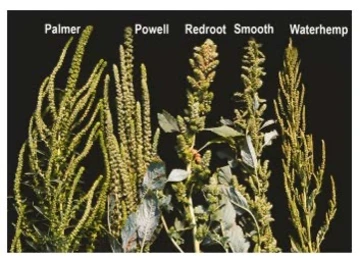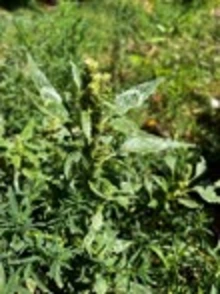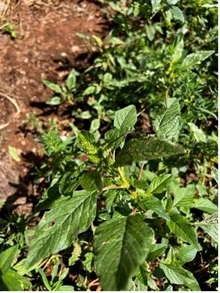Toxic plant pigweed (also known as red root, red root amaranth, parelessweed, palmers amaranth, wild amaranth) is an annual in the amaranth and goosefoot family that ranges in height from 1 to 6 feet. It can have one single large stem, or multiple smaller stems leading to a bushy appearance. At the end of each stem grows a spike of small flowers which can be rough to the touch. Most of the plant is green in color, but leaves may have a white chevron pattern on them, or there may be red on the stems and leaves. Pigweed readily cross germinates with amaranth crops grown for food or seed.
Affected livestock
All classes of livestock, including llamas and alpacas are negatively impacted. Avoid grazing areas during early growth and/or after sudden temperature changes as that is when the plant is the most toxic to livestock. However, toxicity can occur at any time of the plant's growth.
Symptoms
Studies indicate pigweed can cause nitrate and/or oxalate poisoning, and renal failure. Initial symptoms may take days to appear and include labored, shallow and rapid breathing, rapid pulse, body weakness, difficulty walking, and muscle tremors. Pregnant livestock can abort. Studies indicate renal failure is not common unless a large amount of the plant is consumed. Death is likely in extreme cases and may be the only symptom observed.
Diagnosis
Diagnosis is done by a veterinarian to determine if the animal is suffering from nitrate positioning, oxalate poisoning or renal failure. Pigweed poisoning is most common in summer and fall. Since testing is different for each concern, all diagnoses need to be done in a veterinary clinic setting.
Treatment
Remove animals from areas of concern. Provide good quality hay that is weed free and easily digestible. Contact veterinarian immediately. If poisoning is not severe, animals may recover with veterinarian care. Without veterinarian care, death or loss of functional quality of life can occur.
Prevention
Pigweed is a very competitive annual plant that produces hundred of thousands of seeds per plant. It is also resistant to popular herbicides such as glyphosate. Current guidance states that using multiple applications of herbicide in addition to a pre-emergent will reduce plant numbers. Non-herbicide treatments include hand pulling, removing plants with tools, routine tilling to keep plants from going to seed, and routine mowing to keep plants from seeding. Do not use grazing animals to control pigweed.




